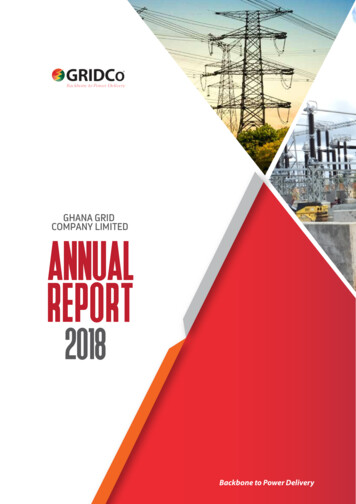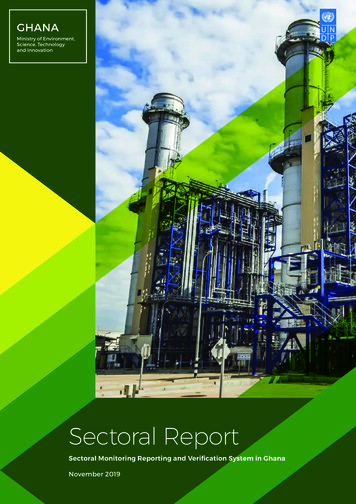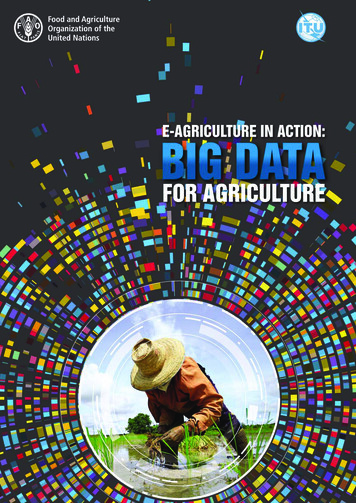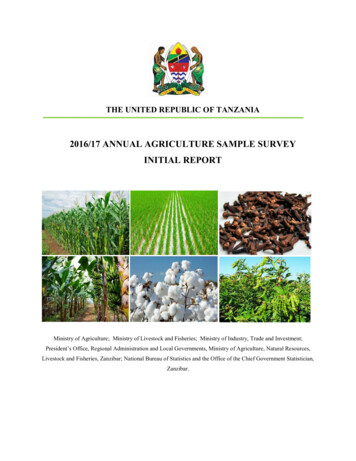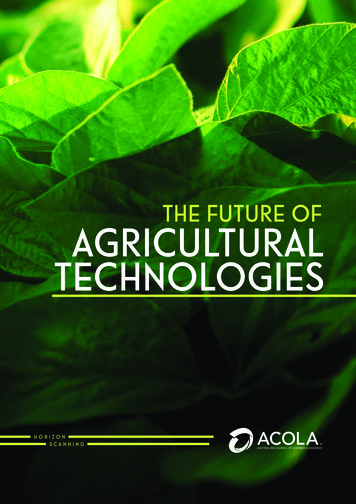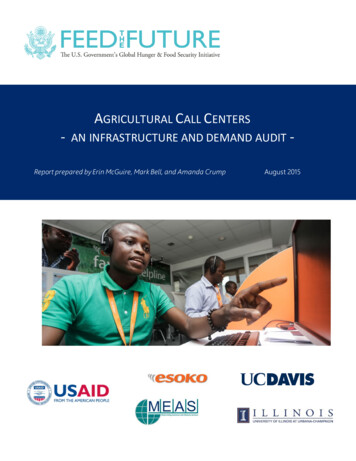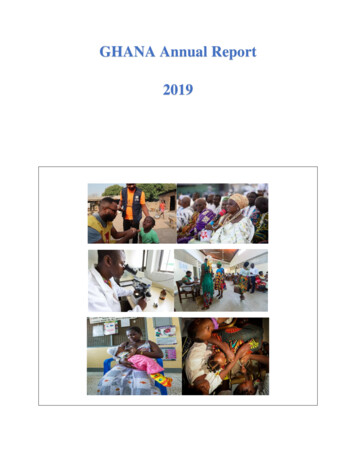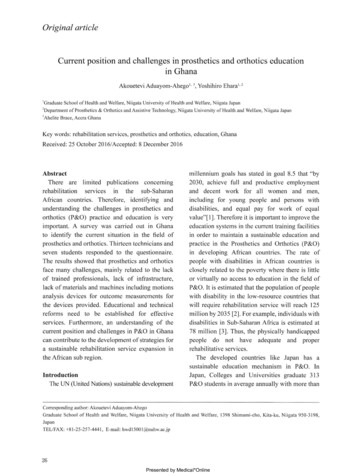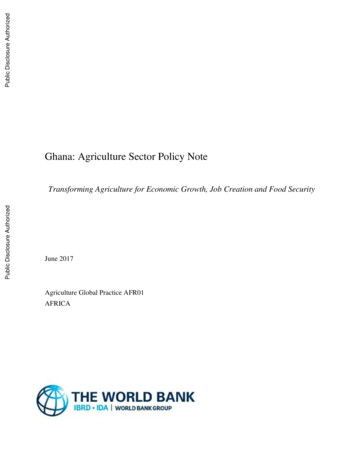
Transcription
Public Disclosure AuthorizedPublic Disclosure AuthorizedPublic Disclosure Authorized.Ghana: Agriculture Sector Policy NoteTransforming Agriculture for Economic Growth, Job Creation and Food Security.June 2017.Agriculture Global Practice AFR01Public Disclosure AuthorizedAFRICA.
Standard Disclaimer:.This volume is a product of the staff of the International Bank for Reconstruction and Development/ The World Bank. The findings,interpretations, and conclusions expressed in this paper do not necessarily reflect the views of the Executive Directors of The World Bankor the governments they represent. The World Bank does not guarantee the accuracy of the data included in this work. The boundaries,colours, denominations, and other information shown on any map in this work do not imply any judgment on the part of The World Bankconcerning the legal status of any territory or the endorsement or acceptance of such boundaries.Copyright Statement:.The material in this publication is copyrighted. Copying and/or transmitting portions or all of this work without permission may be aviolation of applicable law. The International Bank for Reconstruction and Development/ The World Bank encourages dissemination ofits work and will normally grant permission to reproduce portions of the work promptly.For permission to photocopy or reprint any part of this work, please send a request with complete information to the Copyright ClearanceCenter, Inc., 222 Rosewood Drive, Danvers, MA 01923, USA, telephone 978-750-8400, fax 978-750-4470, http://www.copyright.com/.All other queries on rights and licenses, including subsidiary rights, should be addressed to the Office of the Publisher, The World Bank,1818 H Street NW, Washington, DC 20433, USA, fax 202-522-2422, e-mail pubrights@worldbank.org.AcknowledgementsThis note has been prepared by the team of Bank staff and consultants based on a number of sectorstudies and reports from analytical work undertaken over the last few years either through theEconomic Sector Work (P133833) or other analytical studies undertaken to support the existinginvestment projects. The primary author of the note and TTL of the ESW is Johannes (Hans)Jansen, Senior Agricultural Economist. Other team members who provided various inputs include:Kadir Osman Gyasi (Senior Agricultural Economist), Paul Siegel (Consultant) and HardwickTchale (Senior Agricultural Economist). The overall leadership for this work was provided bySimeon Ehui, Practice Manager for Agriculture in the West Africa Region.
Ghana: Agriculture Sector Policy NoteTransforming Agriculture for Economic Growth, Job Creationand Food SecurityThe World Bank GroupAgriculture Global PracticeWest Africa (AFR01)June 20, 2017
ACRONYMS AND ABBREVIATIONS[1 US GHC TERRIAfrica Green Revolution AllianceAgricultural Science and Technology InstituteAgriculture Sector Working GroupAnimal Research InstituteAfghanistan Agricultural Inputs ProjectComprehensive African Agriculture Development ProgramConsultative Group for International Agricultural ResearchCocoa Health and Extension DivisionCocoa Marketing CompanyCocoa Sector Development StrategyCocoa Swollen Shoot Virus DiseaseGhana’s Cocoa BoardCouncil for Scientific and Industrial ResearchCocoa Coffee Sheanut AssociationCrops Research Institute of GhanaDevelopment PartnersEconomic Community of West African StatesFood and Agriculture OrganizationFood and Agriculture Sector Development PolicyForestry Research Institute of GhanaFood Research InstituteGhana Cocoa PlatformGhana Commercial Agriculture ProjectGhana Child Labor Monitoring SystemGhana Irrigation Development AuthorityGross Domestic ProductGhana Statistical ServicesIrrigation Company of the Upper Region of GhanaInternational Food Policy Research InstituteInternational Water Management InstituteKpong Irrigation SchemeKpong Left Bank Irrigation ProjectMinistry of Environment, Science, Technology and InnovationMedium-Term Agriculture Sector Investment PlanMinistry of Lands and Natural ResourcesMinistry of Food and AgricultureNational Food Buffer Stock CompanyNational Program for the Elimination of Child Labor in CocoaNorthern Savannah Ecological ZoneOrganization for Economic Cooperation and DevelopmentOil Palm Research InstitutePlant Genetic Resources InstituteResearch and DevelopmentSavannah Agriculture Research InstituteScheme Management EntitiesScience and Technology Policy Research Institute1
SPDSRIWCFWDIWUAsUSAIDSeed Production DivisionSoil Research InstituteWorld Cocoa FoundationWorld Development IndicatorsWater User AssociationsUnited States Agency for International Development2
CONTENTSAcronyms and Abbreviations . 1Executive Summary . 5Objective of the policy note . 5Context . 5Key constraints to sector growth and competitiveness . 6Specific challenges affecting the cocoa sector. 9Opportunities for transforming agriculture in Ghana . 11Main policy recommendations . 111.Introduction . 14Approach and methodology of the preparation of the policy notes . 16Outline of the report . 162.Agriculture in the Ghana Economy . 17The macro context – role of agriculture in the Ghana economy . 173.Production of major staple crops . 17Cocoa sector performance and issues . 204.Key Constraints to sector growth and competitiveness . 27Ghana’s public expenditure in agriculture . 27Agriculture Research and Development . 33Irrigation Potential in Ghana. 395.Opportunities for agricultural transformation in Ghana . 40Agriculture potential of the Northern Savannah Ecological Zone (NSEZ) . 42The Planting for Food and Jobs Program .466.Key Policy Recommendations . 49Appendix: Summary of Background StudiesBoxesBox 1: Ghana’s Second Generation Cocoa Sector Development Strategy (CSDS II, draft) .24Box 2: Cocoa farm-gate comparative analysis: Ghana and Coted’Ivoire .26Box 3: Key agricultural sector subsidy programs in Ghana .33Box 4: Facilitating the entry of agribusiness investors into Ghana’s irrigation sector 40Box 5: Key Elements of the Planting for Food and Jobs Program .463
FiguresFigure 1: Cereal yield, average for Sub-Saharan Africa . 18Figure 2: Sector contribution to real GDP growth (%) . 18Figure 3.1: Agricultural production by sub-sector, 2014 . 18Figure 3.2: Agricultural growth vs growth in all other sectors (2008-2014) . 19Figure 4: Annual agricultural sector growth rates (trendline) . 20Figure 5. Agricultural terms of trade . 21Figure 6 Public spending in the agricultural sector . 21Figure 7: Organization of the cocoa value-chain in Ghana . 23Figure 8a: Ghana, cocoa prices . 28Figure 8b: Ghana, cocoa producer price as a share of the FOB price (%) . 28Figure 9: Expenditure in agriculture, Ghana compared to other SSA countries . 29Figure 10a: Number of Full-time equivalents (FTE) researchers in Ghana . 35Figure 10b: Funding of Ghana’s national agricultural R&D (US million). 35Figure 11: Population structure, Sub-Saharan Africa and Ghana (2010) . 42Figure 12: NSEZ political regions and districts . 44TablesTable 1: Actual versus potential yields for key staple crops in Ghana . 14Table 2: Productivity growth rates by sector . 17Table 3: Crop production, ‘000 metric tons . 18Table 4: Area cultivated (‘000 hectares) . 19Table 5: Ghana’s position in the global cocoa supply . 22Table 6: Public spending on agriculture, 2001 - 15 . 28Table 7: MOFA financing composition and expenditure breakdown, 2006 - 11 . 30Table 8: Drivers of agricultural productivity growth in Sub-Saharan Africa . 34Table 9: Total area under irrigation (2009-12) . 39Table 10: Summary of Ghana’s merchandise imports . 41Table 11: Agricultural potential zones and their commodity suitability in the NSEZ 45Table 12: Summary of key recommendations .524
EXECUTIVE SUMMARYObjectiveThe objective of this note is to help the Ministry of Food and Agriculture (MoFA) identifystrategic policy directions and reform areas that are fundamental to accelerate and sustainagriculture sector growth. Sustained agricultural growth will contribute to overall resiliency ofthe economy as it undergoes structural transformation as it moves beyond lower middle-incomestatus. The agriculture sector policy note is expected to contribute towards the development of thenext generation of Food and Agriculture Sector Development Policy (FASDEP), its relatedMedium Term Agriculture Sector Investment Plan (METASIP), and the Planting for Food andJobs Program for 2018-2020, which MoFA is currently developing with support from the AfricanGreen Revolution Alliance (AGRA). The Agriculture Sector Policy Note is based on a number ofsector studies and reports prepared by the Bank to support the existing investment projects. Themain audience for this note is MoFA and its development partners united in the Agriculture SectorWorking Group (ASWG). The note will also provide input into the Strategic Country Diagnostics(SCD) and the Country Partnership Framework (CPF) which the Bank will prepare in FY18.ContextThe objective of the Agricultural Sector Policy Note is to help Ghana achieve transformationand modernization of its agriculture sector. There are both challenges and opportunities towardsachieving transformation and modernization of the agriculture sector in Ghana. The country’slower medium-income status supported by a growing extractive industries sector (especially oil)is an opportunity as the growth of the middle class increases the demand for high-quality and safefood products. However, high growth in the extractive sector and concomitant real exchange rateappreciation also present the risk of undermining Ghana’s agricultural competitiveness as has beenobserved in other countries such as Nigeria and Angola. These issues underline the specialchallenges confronting Ghana to sustain and accelerate agriculture growth in the face of economictransformation.The agricultural sector accounts for one-fifth of Ghana’s Gross Domestic Product (GDP),employs nearly half of the workforce and is the main source of livelihood for the majority ofthe country’s poorest households. Two-thirds of non-oil manufacturing depends on agriculturefor raw materials. Agriculture and agribusiness account for a major share of all economic activitiesand livelihoods among smallholder farmers. The major export crop, cocoa, accounts for 20-25percent of total foreign exchange earnings. Ghana accounts for about 20 percent of global cocoaexports and has an international reputation for high quality cocoa beans (which command a 3-5percent market premium). Ghana is also known for its ability to deliver on forward cocoa contractswith little counterpart risk to buyers.Ghana’s agricultural sector is characterized by low yields for both staple and cash crops.Cereal yields are estimated at 1.7 t/ha compared to the regional average of 2.0 t/ha and withpotential yields in excess of 5.0t/ha (World Development Indicators, WDI, 2016).1 Average cocoa1World Development Indicators (WDI). 2016. World Bank, Washington DC, United States of America.5
yield in Ghana, estimated at 400 – 450 kg/ha, is among the lowest in the world (Ghana COCOBOD,2015).2Ghana is a net importer of basic foods (raw and processed) including rice, poultry, sugar,and vegetable oils. The annual food import bill now exceeds the estimated annual 2 billionearned from cocoa exports. Population growth, high rates of urbanization, and increasing incomesare driving the import bill as they lead to increased demand for more quality and safe foodstuffssuch as meat, dairy, and horticulture (fruits & vegetables). In 2015, food imports account for 16.8percent of total merchandise imports estimated at US 13.3 billion,3 and the food import bill isprojected to increase fourfold over the next 20 years, unless local production is substantiallyincreased.Ghana has significant agricultural potential, particularly in the semi-arid NorthernSavannah (agro-)Ecological Zone (NSEZ), including the Afram Plains. Ghana’s agriculturalpotential in the NSEZ remains mostly untapped. The NSEZ covers over 40 percent of the country’stotal surface area, and has about six million hectares of arable land with great potential forcommercial production of cereals, sugarcane, cassava, cotton, cashew, shea and livestock.However, agricultural production in the NSEZ is constrained by inadequate infrastructure(especially roads and irrigation) and other poor socio-economic indicators including low educationand skills, poor access to finance, complicated land tenure arrangements etc. These factors arecompounded by the semi-arid and arid climate which make the savannah particularly susceptibleto environmental degradation and climate change. Irrigation development should therefore receivetop priority in any effort to exploit the productive potential of the NSEZ.Key Constraints to sector growth and competitivenessLow Public Expenditure and EfficiencyGhana’s public expenditure on agriculture has been declining and lags behind the 10 percenttarget agreed as part of the Maputo Declaration. A recent public expenditure review of theagricultural sector by the World Bank estimates that spending on agriculture averaged about 5percent of total spending between 2001 and 2014; while also declining as a percent of total GDPsince 2011 reflecting tightening of the country’s fiscal position (Jansen, 2016).4 This includesfunding to the cocoa sector, implying that non-cocoa public expenditure might only be about halfof the estimated 5 percent. Ghana’s public expenditure on agriculture is among the lowest inAfrica, and considerably below the Comprehensive African Agriculture Development Program(CAADP) commitment of 10 percent (FAO, 2016).5 About two-thirds of the Ministry of Food andAgriculture (MoFA) budget is allocated for operational costs, with Development Partners (DPs)funding more than 70 percent of investment expenditures. Operational costs are mostly allocatedto salaries and input subsidies. This crowds-out expenditure on critical public goods such as accessinfrastructure, irrigation, research and development (R&D), and extension services, among others.Ghana Cocoa Board. 2015. The future of Ghana’s cocoa sector. “Building in robustness and resilience to What IF? ScenarioPlanning Report. Accra, Ghana.3 World Bank. 2015. World Development Indicators (WDI), global merchandise imports.4 Jansen, Johannes, 2016. Revitalizing agricultural growth through enhanced expenditure targeting. World Bank, Accra, Ghana.5 OECD/FAO, 2016. Agriculture in Sub-Saharan Africa: Prospects and challenges, for the next decade. Rome, Italy.26
There are also issues related to agricultural services which have been devolved to the DistrictAssemblies. Although Ghana has implemented its decentralization policy, but a lot still needs tobe done to give full meaning to administrative and fiscal decentralization, particularly for keysectors such as agriculture whose functions and services are needed most at the local level. Theprovision of agricultural extension and other services at the local level remains rather poor, mainlydue to low capacity and limited and untimely provision of public funding.A significant part of agricultural public expenditure is for input subsidies, yet evidence showsthat these subsidies are inefficient and generate low returns. The government providesfertilizer subsidies through MoFA as well as to cocoa farmers through COCOBOD. In 2016,MoFA provided subsidies on 180,000 metric tons of granular fertilizer at a cost of GH 120million and an unspecified quantity of organic fertilizer at a cost of GH 18 million, representingan average subsidy of 26 percent. In the cocoa sector, COCOBOD is the principal supplier offertilizers, pesticides and seedlings. The sustainability of these programs is of concern, given theirrising costs and ineffective targeting mechanisms. There are also operational issues, such as lateannouncements regarding if, when and how the programs are to be implemented each year,resulting in late delivery of fertilizers and creating substantial uncertainty for input suppliers andhindering the development and strengthening of private fertilizer supply networks in the country.(Houssou, Kolavalli, Silver, 2016).6 Where subsidies must be implemented in order to addressspecific market failures affecting farmers’ uptake of inputs, there is need to ensure adherence tothe principles of smart subsidies, including: (a) targeting farmers that need to learn about properuse of fertilizers; (b) targeting farmers that could use fertilizers profitably but are not able to do sodue to working capital constraints; and (c) delivering the subsidy through the private sector byusing modern voucher systems.Agricultural R&D, which is a key driver of productivity growth is inadequately funded andcoordinated. In Ghana, spending on agricultural R&D amounts to about 0.7 percent of agriculturaloutput (excluding cocoa), above the Sub-Saharan Africa average of 0.5 percent, but below the ratesof regional leaders such as Kenya (1.4 percent) and South Africa (2 percent) (IFPRI/ASTI, 2014).7This is also lower than the 1 percent target set by the African Union. Ghana’s institutionalmechanism for agricultural research and development is governed by the Council for Scientificand Industrial Research (CSIR). It is estimated that less than 4 percent of the budget annuallyallocated to CSIR is available to finance new operations. As a result, researchers are almost fullydependent on donor funding which is also limited.Significant productivity growth in agriculture requires a vibrant agricultural input supplysystem, particularly for seed. Ghana’s seed sector has undergone some significant changes in thepast few years, including the establishment of a new seed law and regulations, the appointment ofa National Seed Council, and the emergence of a more diversified commercial seed sector. Tripand Mensah-Bonsu (2013)8 reviewed factors critical to the development of the seed sector6Houssou, Nazaire; Kolavalli, Shashidhara; Silver, Jed. 2016. Agricultural intensification, technology adoption, andinstitutions in Ghana. Washington DC: IFPRI. 2016.7Nienke Beintema, Gert-Jan Stads, Keith Fuglie, and Paul Heisey, 2012. Global assessment of agricultural R&Dspending. Agricultural Science and Technology Indicators (ASTI) and International Food Policy Research Institute(IFPRI).8Trip, Robert and Akwasi Mensah-Bonsu, 2013. Ghana’s commercial seed sector: New incentives or continuedcomplacency. Ghana Strategy Support Program. International Food Policy Research Institute Working Paper 32.7
including procedures regarding variety release, seed quality inspection and certification; consumerprotection; access to breeder seed; provision of information to farmers; and seed prices andsubsidies. They also evaluated the traits of major public sector crop varieties, the nature of farmersseed demand, and the composition of the local seed industry. They concluded that the seed systemin Ghana is still largely dependent on public support (with minimal private sector participation),and the seed value-chain (from the production of breeder seed, foundation seed, its multiplication,and the production and distribution of certified seed) has inherent cost inefficiencies that invariablyaffect the competitiveness of the domestic seed industry. Furthermore, with the limiteddevelopment of the private sector in this important area, access to good quality seed amongsmallholder farmers remains a major issue.The coordination of agricultural sector investments in Ghana needs to be improved. Sectorcoordination is mainly done through the Agriculture Sector Working Group (ASWG) led byMoFA. The ASWG is a policy dialogue platform for engaging the Government of Ghana and itsDevelopment Partners (DPs). The ASWG coordinates the alignment towards the Food andAgriculture Sector Development Plan (FASDEP II), supports the implementation of the mediumterm investment plan, and facilitates the preparation of Joint Annual Sector Reviews. However,more needs to be done to strengthen ASWG’s impact on sector policy formulation, as well asmonitoring and evaluation. Over the last two years, MoFA’s participation and leadership has beeninconsistent. Furthermore, the funding of METASIP, including its steering and governancestructures remains inadequate. The coordination of the DPs’ support to the sector needs to beimproved. The framework and capacity to facilitate public-private partnerships (PPPs) in the sectorneeds to be strengthened to further private sector investment in agriculture.The collection and analysis of agricultural data/statistics is still weak and this underminesproper development planning in the sector. Ghana has not conducted a comprehensiveagricultural census for the past 32 years.9 In order to obtain annual production data, MoFA relieson Annual Crop and Livestock Surveys conducted at the district level by agricultural extensionofficers. However, given the limited public funding and other constraints affecting the capacity ofpublic officials, the quality of the data is often challenged.Impact of Climate ChangeGhana’s agriculture is vulnerable to the threat of climate change. Approximately 70 per centof the population directly or indirectly depends on agriculture and forestry. The agriculturalsector’s vulnerability to climate change effects threatens the food security and livelihoods of themajority who depend on the sector. While the diversity of agro-climatic conditions, productionsystems, and crops prevalent in Ghana lowers the level of aggregate risk for the agricultural sectoras a whole, the sector faces climate change effects whose causes, frequency, and severity varybetween regions, commodities, and years, with strong implications for localized risk managementstrategies. According to a report by the World Bank10, climate change is expected to adverselyaffect the stability of Ghana’s agricultural sector with the country’s millions of smallholder farmers9Quiñones, Esteban J.; Muñoz, Juan and Ngeleza, Guyslain. 2011. A Strategy for Agricultural Statistics in Ghana. GhanaStrategy Support Program. International Food Policy Research Institute Working Paper 32. According to this paper, the lastagricultural census in Ghana was conducted in 1984.10Choudhary, Vikas; D'Alessandro, Stephen. 2015. Ghana Agricultural Sector Risk Assessment: Risk Prioritization. WorldBank, Washington, DC. World Bank. 2498 License: CC BY 3.0 IGO.8
particularly vulnerable. The report also highlight that climate change is projected to accentuate therise in food prices in the future. While the price of rice is projected to increase 60 percent by 2015without climate change, it could go up by as much as 121 percent once climate change is takeninto account. Similarly, while the price of maize is projected to increase 60 percent without climatechange, with climate change this increase could be 153 percent. Northern Ghana is more vulnerableto increased volatility in weather patterns caused by climate change than the rest of the countrybecause it is poorer, drier and more heavily dependent on subsistence agriculture. It is thereforeimportant for Ghana to deepen the implementation of its National Climate Change Policy (NCCP)and the Agriculture Sector Implementation Plan, following the set principles in line with thecountry’s Intended Nationally Determined Contributions (INDC) towards climate changemitigation.Specific challenges affecting the Cocoa SectorCocoa is very important to Ghana in terms of rural livelihoods, foreign exchange earningsand employment, as well as being a key driver of sector growth. Cocoa accounts for about 7percent of the country’s GDP and 20-25 percent of total export earnings. Ghana is the second mostimportant producer and exporter of cocoa in the world, accounting for about 20-25 percent of totalworld supply. Total production increased from 400,000 MT in 1999-2000 to 1,000,000 MT in2011-2012, but dropped to about 850,000 MT in 2013-2014, and has been fluctuating between750,000-850,000 MT/year since.The cocoa sector’s low productivity threatens Ghana’s competitiveness and position in theinternational market. The low yields are a result of a multiplicity of factors such as age of thetrees, pest and disease infestation, and poor agricultural practices. According to a recentassessment by the World Cocoa Foundation (WCF, 2016),11 of the 2.6 million hectares undercocoa, about 23 percent have trees that are above 30 years old, and about 7 percent have beenaffected by cocoa swollen shoot virus disease (CSSVD). During the past decades, growth in totalcocoa output has been more a result of expansion of area under cultivation than yield increase dueto technical change.Ghana’s Cocoa Sector Development Strategy (CSDS II)12seeks to modernize Ghana’s cocoasector and promote climate smart cocoa and enhance the productivity of farms, but is yet tobe finalized and approved. The vision and strategy for modernizing Ghana’s cocoa sector isbased on three pillars: competitiveness, resilience, and robustness. To modernize and have a moresustainable cocoa sector, Ghana needs to be more: (a) competitive by increasing the productivityof cocoa producers and improve cost efficiency along the cocoa supply chain; (b) resilient tochallenges and risks related to global cocoa markets (demand and supply), and climate change;and (c) robust by being an industry leader through innovation and differentiation by focusing onhigh quality cocoa and niche markets.11World Cocoa Foundation (WCF), 2016. Cocoa Swollen Shoot Virus Disease: A holistic approach to control thedisease in West Africa.12Developed by COCOBOD with support from the World Bank, World Cocoa Foundation (WCF) and the RoyalNetherlands Embassy between January 2014 and March 2015.9
There is a need to reconsider COCOBOD’s cocoa inputs program for fertilizer, agrochemicals and planting materials. The Ghana Cocoa Board (COCOBOD) which governs thecocoa sector implements a distribution program for fertilizer, agro-chemicals and plantingmaterials. Cocoa planting materials (pods and seedlings) are supplied through its Seed ProductionDivision (SPD) and Cocoa Health and Extension Division (CHED) to farmers. Additionally,COCOBOD procures fertilizer and agrochemicals and distributes them to the farmers under itsCocoa High-Tech Program. Even though the distribution, as communicated within the publicdomain, creates an impression that these inputs are supplied for free, in reality farmers pay forthem th
yield in Ghana, estimated at 400 – 450 kg/ha, is among the lowest in the world (Ghana COCOBOD, 2015).2 Ghana is a net importer of basic foods (raw and processed) including rice, poultry, sugar, and vegetable oils. The annual food import bill now exceeds t
